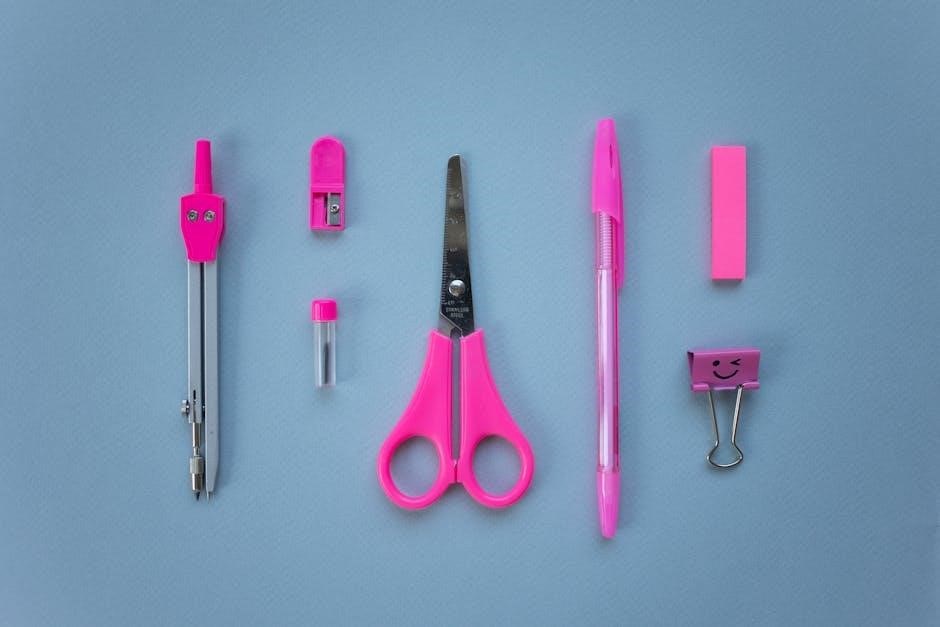Lansky Sharpeners are renowned for their precision and ease of use‚ offering a controlled-angle sharpening system that ensures razor-sharp edges. Perfect for both professionals and home users‚ they provide versatile models to suit every sharpening need.
1.1 Overview of the Lansky Sharpening System
The Lansky Sharpening System is a versatile and user-friendly tool designed to achieve precise knife sharpening. It offers a controlled-angle sharpening method‚ allowing users to maintain consistent edges. The system includes various models‚ such as the Controlled-Angle Sharpening System and the Tactical Sharpening Rod‚ catering to different needs. Lansky sharpeners are known for their ease of use‚ making them ideal for both professionals and home users. They support multiple sharpening angles (e.g.‚ 17°‚ 20°‚ 25°‚ and 30°) to accommodate various blade types. The system ensures razor-sharp results with minimal effort‚ making it a reliable choice for knife enthusiasts and outdoor enthusiasts alike.
1.2 Importance of Proper Sharpening
Proper sharpening is essential for maintaining knife performance‚ safety‚ and longevity. A dull blade requires more force‚ increasing the risk of accidents and making tasks more difficult. Sharpening ensures a clean‚ precise cut‚ reducing fatigue and improving efficiency. Regular sharpening prevents blades from becoming overly worn‚ extending their lifespan. Additionally‚ a sharp knife is more reliable in critical situations‚ such as outdoor or survival scenarios. Lansky Sharpeners are designed to make sharpening consistent and straightforward‚ helping users achieve professional-grade results. Proper sharpening not only enhances functionality but also preserves the quality of the blade‚ making it a crucial skill for knife enthusiasts and professionals alike.

Components of the Lansky Sharpener
The Lansky Sharpener includes a frame‚ sharpening rods‚ angle guides‚ and a clamp. It offers interchangeable rods for different blade types and sharpening needs‚ ensuring precision and adaptability.
2.1 Unpacking the Lansky Sharpener Kit
Unpacking the Lansky Sharpener Kit is straightforward. Carefully remove all components from the box‚ ensuring no items are damaged. The kit typically includes a sharpening frame‚ multiple sharpening rods of varying grits‚ angle guides‚ a knife clamp‚ and an instruction manual. Each item is designed for specific functions‚ so inspecting them helps familiarize you with their roles. The frame serves as the base‚ while the rods handle the actual sharpening. Angle guides assist in maintaining the correct sharpening angle‚ and the clamp securely holds the blade in place. Properly organizing these components ensures efficient use and optimal sharpening results. Follow the manual for setup guidance.
2.2 Key Components and Their Functions
The Lansky Sharpener Kit includes several key components designed to streamline the sharpening process. The sharpening frame serves as the base‚ providing stability and a platform for attaching other parts. The sharpening rods‚ available in different grits‚ are used to hone and polish the blade. Angle guides ensure consistent sharpening angles‚ crucial for achieving the desired edge. The knife clamp securely holds the blade in place‚ accommodating various thicknesses. Additionally‚ the kit includes a thumb screw for adjusting the clamp and a user manual with step-by-step instructions. Each component is engineered to work together seamlessly‚ making the sharpening process precise and efficient for users of all skill levels.
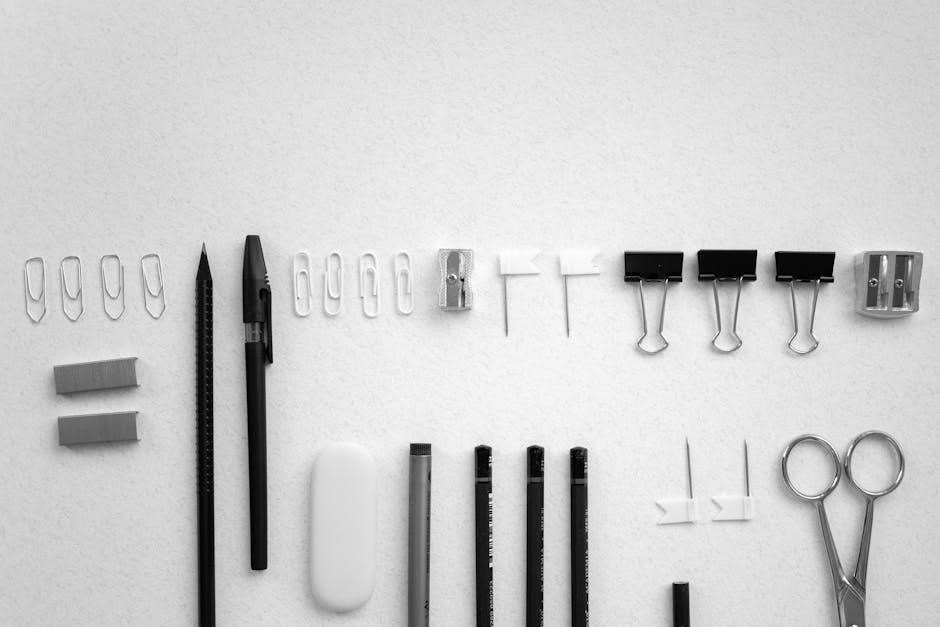
Setting Up the Lansky Sharpener
Start by carefully unpacking the Lansky sharpener‚ ensuring all components are included. Prepare the frame‚ attach the knife clamp‚ and assemble the sharpener according to instructions for optimal use.
3.1 Unpacking and Preparing the Sharpener
Begin by carefully unpacking the Lansky sharpener kit‚ ensuring all components are included. Gently remove the sharpener from its packaging and inspect for any damage. Lay out the frame‚ knife clamp‚ sharpening rods‚ and angle guides on a clean‚ flat surface. Familiarize yourself with each part and its function. Before use‚ ensure the frame is securely assembled and the clamp is ready to accommodate different blade thicknesses. Proper preparation ensures a smooth and effective sharpening process. Always refer to the instructions for specific assembly details to avoid errors.
3.2 Assembling the Sharpener for Use
Assembling the Lansky sharpener is straightforward. Start by attaching the knife clamp to the frame‚ ensuring it is securely fastened. Next‚ select the appropriate sharpening rods based on the type of edge you wish to achieve and insert them into the designated guide holes. Align the rods with the angle marks to maintain consistency. For most knives‚ a 20° or 25° angle is recommended. Once the rods are in place‚ tighten all screws firmly to ensure stability. Double-check that the clamp is properly positioned to accommodate the blade thickness. A well-assembled sharpener guarantees precise control and even sharpening. Always ensure the setup is stable before proceeding.
Attaching the Knife Blade
Attach the knife blade by loosening the front screw of the clamp to accommodate the blade’s thickness. Secure the clamp to the spine or back of the blade‚ ensuring it is held firmly in place for precise sharpening.
4.1 Securing the Blade Correctly
To secure the blade correctly‚ start by loosening the front screw of the knife clamp using a dime or your finger to accommodate the blade’s thickness. Next‚ carefully attach the clamp to the spine or back of the blade‚ positioning it two finger widths away from the edge you wish to sharpen. Ensure the blade is aligned properly and held firmly in place. For even sharpening‚ you can mark the blade with a marker and use the clamp as a guide. Tighten the screw firmly to secure the blade‚ but avoid over-tightening‚ which could damage the clamp or blade. Properly securing the blade is essential for achieving precise and consistent results.
4.2 Adjusting the Clamp for Blade Thickness
Adjusting the clamp for blade thickness is crucial for effective sharpening. Begin by loosening the front screw of the knife clamp to create space for the blade. Insert the blade into the clamp‚ ensuring it rests firmly against the backstop. Slowly tighten the screw until the blade is held securely‚ being careful not to overtighten‚ as this could bend thinner blades. For thicker blades‚ additional pressure may be needed to ensure stability. Once the blade is secure‚ double-check its alignment to ensure even sharpening. Proper adjustment ensures the blade remains steady throughout the sharpening process‚ promoting consistent results and preventing damage to the knife. This step ensures optimal sharpening performance and longevity of the blade.

Choosing the Right Sharpening Angle
Selecting the correct angle is vital for effective sharpening. Lansky sharpeners offer preset angles (17°‚ 20°‚ 25°‚ and 30°) for different blade types and uses‚ ensuring optimal results.
5.1 Understanding Different Sharpening Angles
Sharpening angles play a crucial role in achieving the desired edge sharpness and durability. Lansky sharpeners offer preset angles‚ such as 17°‚ 20°‚ 25°‚ and 30°‚ each tailored for specific tasks. A 17° angle is ideal for razor-sharp edges‚ suitable for precision tools like straight razors or X-Acto knives. The 20° angle is a versatile option for general-purpose knives‚ balancing sharpness and durability. For heavier use‚ such as cutting cardboard or wire‚ the 25° angle is recommended‚ while the 30° angle is best for axes or chopping tools‚ providing a robust edge. Understanding these angles ensures optimal performance for your specific needs.
5.2 Selecting the Appropriate Angle for Your Knife
Selecting the right sharpening angle is essential for achieving the desired edge and maintaining the knife’s performance. For everyday knives‚ such as chef or utility knives‚ a 20° angle is ideal‚ providing a balance between sharpness and durability. Heavier-duty knives‚ like those used for cutting cardboard or wire‚ benefit from a 25° angle‚ which creates a stronger edge. For precision tools‚ such as straight razors or X-Acto knives‚ a 17° angle delivers an extremely sharp‚ albeit delicate‚ edge. Axes and chopping tools perform best at a 30° angle‚ ensuring robustness. Lansky sharpeners include angle guides to help you set and maintain the correct angle consistently.
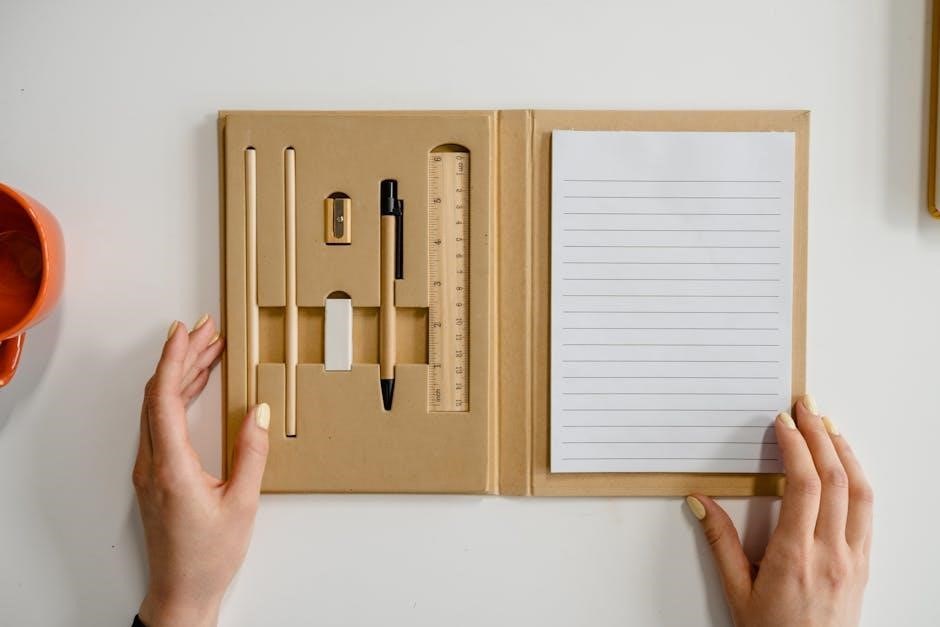
The Sharpening Process
The Lansky sharpening process involves setting the desired angle‚ securing the knife‚ and pulling it through the sharpener. Repeat on both sides for a razor-sharp edge.
6.1 Step-by-Step Guide to Sharpening
Start by securing the knife blade in the Lansky sharpener’s clamp‚ ensuring it is tightly held. Next‚ choose the desired sharpening angle and insert the sharpening rods into the corresponding guide holes. Gently pull the knife through the sharpener in a smooth‚ consistent motion. Repeat this process several times‚ flipping the knife to sharpen both sides evenly. After completing the sharpening‚ inspect the edge for sharpness and repeat if necessary. Finally‚ clean the sharpener and store it properly. This method ensures a precise‚ razor-sharp edge every time‚ making Lansky sharpeners a reliable choice for all knife owners.
6.2 Maintaining Consistency and Control
Maintaining consistency and control is crucial for achieving optimal results with the Lansky sharpener. Always ensure the knife is securely clamped and aligned properly before starting. Use the guide holes to maintain the selected sharpening angle‚ and apply consistent pressure while pulling the knife through the sharpener. To avoid uneven edges‚ sharpen both sides of the blade equally. Periodically inspect the edge to track progress and adjust as needed. Keep the sharpening rods clean and free of debris to ensure smooth operation. By following these steps‚ you can maintain precise control and achieve a consistently sharp edge with every use of the Lansky sharpener.
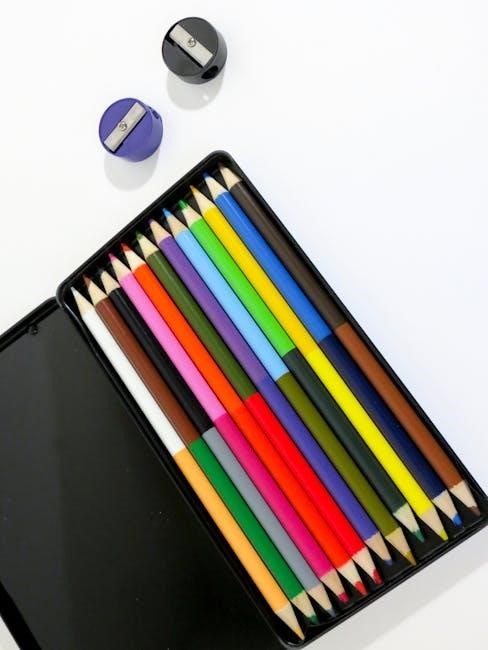
Sharpening Different Types of Blades
Lansky sharpeners efficiently handle both straight-edge and serrated blades‚ utilizing specific surfaces and angles tailored to each blade type for optimal sharpening results.
7.1 Sharpening Straight-Edge Blades
Sharpening straight-edge blades with a Lansky sharpener is straightforward. Place the blade in the clamp‚ ensuring it’s secure and aligned properly. For straight edges‚ use the flat sharpening surfaces‚ typically at a 20° or 25° angle. Hold the sharpener firmly and pull the blade through the sharpening rods in a smooth‚ consistent motion. Repeat this process several times‚ flipping the blade to sharpen both sides evenly. This method ensures a razor-sharp edge while maintaining the blade’s original geometry. Always maintain light pressure and consistent angle control for optimal results. This technique works well for kitchen knives‚ utility blades‚ and other straight-edge tools.
7.2 Sharpening Serrated Blades
Sharpening serrated blades requires a slightly different approach. Position the blade in the clamp‚ ensuring the serrations face the sharpening rod. Use the edge of the sharpening rod specifically designed for serrations‚ typically found on Lansky models. Lightly draw the rod along each serration‚ maintaining the blade’s original angle. Repeat this process for each serration‚ moving from heel to tip. Avoid applying too much pressure‚ as this could damage the serrated edge. After sharpening‚ inspect the blade to ensure even sharpness. This method is ideal for serrated knives‚ saw blades‚ or specialized tools‚ restoring their cutting efficiency effectively.

Maintenance and Cleaning
Regularly clean the sharpener with a dry cloth after use to remove metal particles. Store in a dry place to prevent rust and ensure optimal performance.
8.1 Cleaning the Sharpener After Use
Cleaning the Lansky Sharpener after use is essential to maintain its performance. Use a dry cloth to wipe away metal particles and debris from the sharpening rods and surfaces. Avoid using harsh chemicals or submerging the sharpener in water‚ as this may damage the materials. For diamond stones‚ clean them with mild soap and water‚ then rinse thoroughly and dry. Ceramic rods can be cleaned similarly‚ ensuring no abrasive materials are used. Regular cleaning prevents rust and ensures the sharpener remains effective for future use. Proper maintenance extends the lifespan of the sharpener and guarantees consistent results when sharpening knives.
8.2 Maintaining the Sharpener’s Performance
To maintain the Lansky Sharpener’s performance‚ regular inspection and upkeep are crucial. After cleaning‚ inspect the sharpening rods and surfaces for wear or damage; Replace any worn-out components promptly to ensure consistent results. Store the sharpener in a dry‚ protected area to prevent rust or corrosion. Proper alignment and tightening of all parts are essential for optimal function. Additionally‚ using the correct sharpening angles and techniques will prevent unnecessary strain on the sharpener. By following these maintenance steps‚ you can ensure the Lansky Sharpener remains in excellent condition‚ providing precise sharpening results for years to come. Regular maintenance is key to preserving its effectiveness and longevity.

Tips for Achieving the Best Results
Use the correct technique‚ maintain a consistent angle‚ and apply light strokes for optimal sharpening. Regular practice and proper blade alignment will yield the sharpest edges.
9.1 Using the Correct Technique
Mastering the correct technique with a Lansky Sharpener is essential for achieving razor-sharp results. Start by securing the blade firmly in the clamp‚ ensuring it is aligned properly. Next‚ choose the appropriate sharpening angle based on the knife’s intended use. For most knives‚ a 20° angle is ideal‚ while a 25° angle suits heavier-duty blades. Hold the sharpener steady and pull the blade through the sharpening rods with light‚ consistent pressure. Maintain control throughout the stroke to avoid applying too much force‚ which could damage the edge. Repeat the process on the other side of the blade for a balanced edge. This method ensures precision and prevents uneven sharpening‚ maximizing the knife’s performance and longevity. Regular practice will help refine your skills‚ making sharpening a quick and effortless task.
9.2 Avoiding Common Mistakes
When using a Lansky Sharpener‚ avoiding common mistakes ensures optimal results. One frequent error is improper blade alignment‚ which can lead to uneven sharpening. Always position the blade correctly in the clamp‚ ensuring it is secure and straight. Another mistake is applying too much pressure‚ which can damage the edge or the sharpening rods. Use light‚ consistent strokes instead. Over-sharpening is also a pitfall; stop once the knife reaches the desired sharpness. Additionally‚ failing to choose the correct angle for the knife’s intended use can result in a poor edge. To avoid these issues‚ follow the manual’s guidelines‚ double-check blade alignment‚ and practice moderation in both pressure and strokes. This ensures a precise‚ durable edge every time.
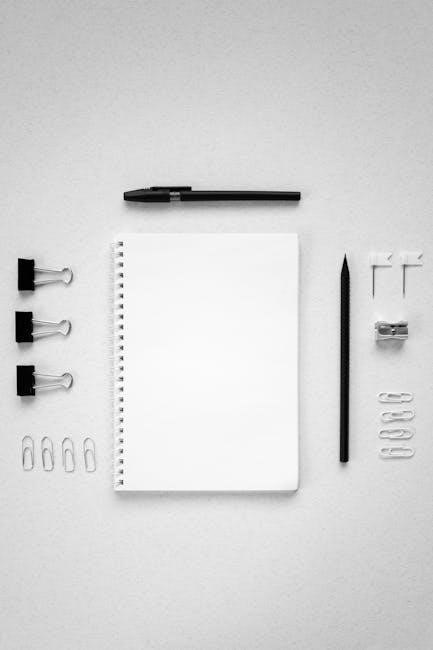
Troubleshooting Common Issues
Identify and address issues like misaligned blades or uneven sharpening by referring to the manual. Adjust the clamp or angle setting to resolve these common problems effectively.
10.1 Diagnosing Sharpening Problems
Identifying issues with your Lansky Sharpener is crucial for maintaining optimal performance. Common problems include uneven sharpening‚ blades not sharpening at the correct angle‚ or the sharpener malfunctioning. Start by inspecting the blade alignment and ensuring it is properly secured in the clamp. Check for any debris or damage to the sharpening rods or surfaces. If the blade is not sharpening evenly‚ verify that the angle guide is correctly set and the rods are clean. Consult the user manual for specific troubleshooting steps‚ as improper assembly or worn parts may also cause issues. Addressing these problems early ensures consistent results.
10.2 Adjustments for Optimal Performance
To ensure peak performance‚ regular adjustments to your Lansky Sharpener are essential. Begin by calibrating the sharpening angle to match your knife’s requirements‚ using the guide holes provided. Check the blade clamp’s tension to ensure a secure hold without damaging the knife. Clean the sharpening rods or stones after each use to remove metal particles and maintain their effectiveness. Additionally‚ inspect the alignment of the sharpening guides and adjust as needed to achieve consistent results. For optimal performance‚ periodically check for wear on moving parts and tighten any loose screws. Refer to the user manual for detailed guidance on making these adjustments effectively.
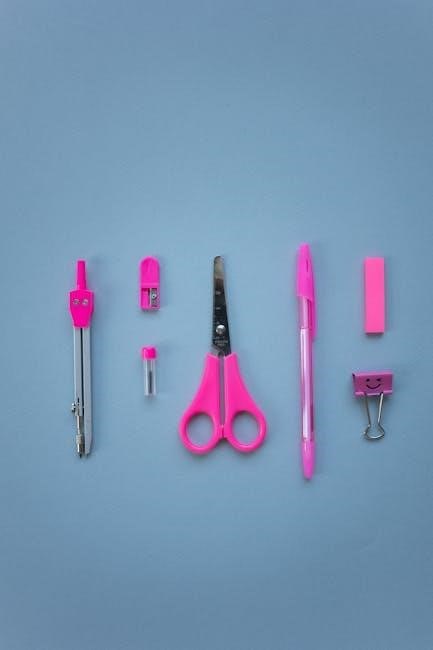
Comparing Lansky to Other Sharpeners
Lansky Sharpeners excel with their precision-controlled angles and durable diamond stones‚ offering superior edge retention compared to other systems. Their user-friendly design and versatility set them apart‚ making them a top choice for both professionals and enthusiasts.
11.1 Unique Features of Lansky Sharpeners
Lansky Sharpeners are distinguished by their Controlled-Angle Sharpening System‚ ensuring precise edge alignment. They feature interchangeable diamond and ceramic stones for versatility. The adjustable clamp accommodates various blade thicknesses‚ while the guide holes allow for customizable sharpening angles. Lansky also offers a range of models‚ from compact tactical sharpeners to deluxe multi-stone systems. Their designs cater to both straight-edge and serrated blades‚ with specialized tools for hooks and serrations. The system’s portability and ease of use make it ideal for outdoor enthusiasts and professionals. Lansky’s commitment to durability and precision sets it apart‚ providing long-lasting performance with minimal maintenance required.
11.2 Benefits Over Other Sharpening Tools
Lansky Sharpeners offer superior precision with their controlled-angle system‚ ensuring consistent results. Unlike freehand sharpening‚ Lansky’s guides eliminate guesswork‚ delivering uniform edges. The interchangeable stones provide versatility for different blade types. Lansky’s portability and ease of setup make it ideal for both home and field use. The ability to sharpen serrated edges and hooks sets it apart from basic sharpeners. Lansky’s durability ensures long-term performance‚ while its cost-effectiveness provides excellent value. These features make Lansky a preferred choice for professionals and outdoor enthusiasts seeking reliable‚ high-quality sharpening without the need for expensive or complex equipment.
Lansky Product Range
Lansky offers a versatile range of sharpeners‚ including the Controlled-Angle System‚ Tactical Sharpening Rod‚ and Multi-Sharpener‚ catering to different needs for kitchen‚ tactical‚ and serrated blades.
12.1 Different Models Available
Lansky provides a diverse range of sharpening tools tailored to various needs. Their product line includes the Controlled-Angle Sharpening System‚ ideal for precise knife sharpening‚ the Tactical Sharpening Rod‚ designed for outdoor and survival knives‚ and the Multi-Sharpener‚ which accommodates both straight-edge and serrated blades. Additionally‚ Lansky offers the Masters Edge All Diamond Sharpener and the Diamond Ceramic Turnbox‚ catering to users seeking advanced sharpening solutions. Each model is engineered to deliver superior results‚ ensuring that every knife achieves a razor-sharp edge with minimal effort. This variety allows users to choose the perfect sharpener for their specific requirements‚ whether for culinary‚ tactical‚ or everyday use.
12.2 Choosing the Right Model for Your Needs
Selecting the appropriate Lansky model depends on your sharpening requirements. For everyday kitchen use‚ the Controlled-Angle System is ideal‚ offering simplicity and precision. Outdoor enthusiasts may prefer the Tactical Sharpening Rod for its portability and durability. The Multi-Sharpener is versatile‚ handling both straight-edge and serrated blades‚ while the Masters Edge All Diamond Sharpener is perfect for advanced users seeking superior edge refinement. Consider blade types‚ frequency of use‚ and personal skill level when making your choice. Lansky’s diverse range ensures there’s a model to match every need‚ providing optimal performance and ease of use for achieving professional-grade sharpness at home or in the field.
Safety Precautions
Always wear protective gloves and eyewear when using the Lansky Sharpener. Keep fingers away from sharpening rods and ensure a stable work surface to prevent accidents and injuries.
13.1 Handling the Sharpener Safely
Always wear protective gloves and eyewear when using the Lansky Sharpener to prevent injuries. Ensure the sharpener is placed on a stable‚ flat surface away from children. Avoid loose clothing that might get caught in the sharpening rods. Keep fingers away from the sharpening stones and never touch the edges during the process. Use the provided clamps to securely hold the knife‚ maintaining control at all times. Regularly inspect the sharpener for wear and tear‚ and follow the manufacturer’s guidelines for maintenance. Proper handling ensures a safe and effective sharpening experience‚ protecting both the user and the equipment.
13.2 Protecting Yourself and Others
Always store the Lansky Sharpener out of reach of children and pets to prevent accidental injuries. After sharpening‚ carefully inspect the blade for sharpness and store it safely. Ensure the sharpening area is clear of distractions and tripping hazards. Never sharpen near open flames or sparks. Dispose of any metal shavings responsibly. Keep the sharpening rods and stones clean and dry to prevent rust. Regularly check for any loose parts on the sharpener and tighten them as needed. By following these precautions‚ you protect yourself‚ others‚ and maintain the sharpener’s performance for years to come‚ ensuring a safe and effective sharpening process.
Lansky Sharpeners offer precision‚ ease‚ and consistent results‚ making them ideal for all users. Their controlled-angle systems ensure razor-sharp edges‚ enhancing both functionality and safety for every knife.
14.1 Summary of Key Points
Lansky sharpeners are a top choice for achieving precision and ease in knife sharpening. They offer a controlled-angle system‚ ensuring consistent results for both straight-edge and serrated blades. The system’s versatility allows users to sharpen various knife types‚ from kitchen knives to survival tools. Key features include easy blade attachment‚ adjustable clamps‚ and multiple sharpening angles. Proper technique and maintenance are emphasized to prolong the sharpener’s performance. By following the instructions and tips provided‚ users can master the sharpening process‚ ensuring their knives remain razor-sharp and functional. Lansky sharpeners are a valuable tool for anyone seeking reliable and professional-grade sharpening results.
14.2 Final Tips for Effective Sharpening
To achieve the best results with your Lansky sharpener‚ always maintain consistent angles and use the appropriate sharpening rods for your blade type. Regularly clean the sharpener to ensure optimal performance and extend its lifespan. Store the sharpener in a dry place to prevent rust or damage. Practice proper blade attachment and clamp adjustment to avoid uneven sharpening. For serrated blades‚ use the specialized edges or grooves designed for such tasks. Finally‚ always follow the manufacturer’s instructions and safety guidelines to ensure safe and effective sharpening. By mastering these techniques‚ you’ll keep your knives in peak condition and extend their utility for years to come.
